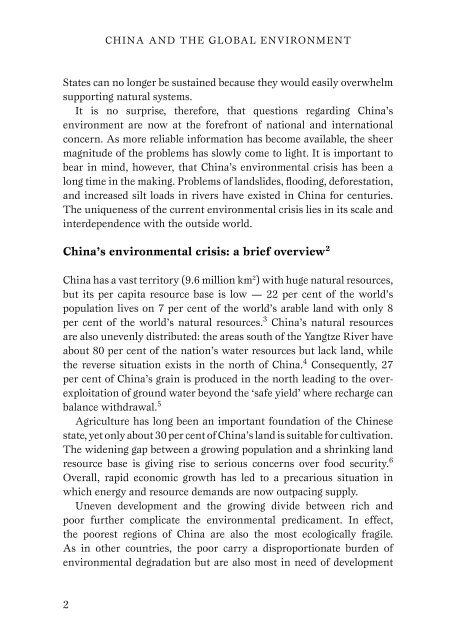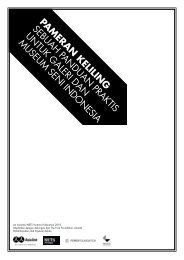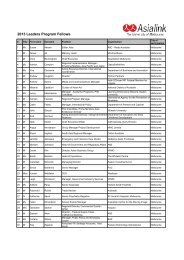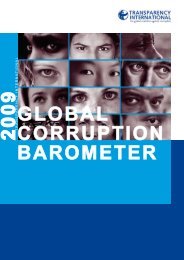China and the global environment - Asialink
China and the global environment - Asialink
China and the global environment - Asialink
Create successful ePaper yourself
Turn your PDF publications into a flip-book with our unique Google optimized e-Paper software.
CHINA AND THE GLOBAL ENVIRONMENTINTRODUCTIONStates can no longer be sustained because <strong>the</strong>y would easily overwhelmsupporting natural systems.It is no surprise, <strong>the</strong>refore, that questions regarding <strong>China</strong>’s<strong>environment</strong> are now at <strong>the</strong> forefront of national <strong>and</strong> internationalconcern. As more reliable information has become available, <strong>the</strong> sheermagnitude of <strong>the</strong> problems has slowly come to light. It is important tobear in mind, however, that <strong>China</strong>’s <strong>environment</strong>al crisis has been along time in <strong>the</strong> making. Problems of l<strong>and</strong>slides, flooding, deforestation,<strong>and</strong> increased silt loads in rivers have existed in <strong>China</strong> for centuries.The uniqueness of <strong>the</strong> current <strong>environment</strong>al crisis lies in its scale <strong>and</strong>interdependence with <strong>the</strong> outside world.<strong>China</strong>’s <strong>environment</strong>al crisis: a brief overview 2<strong>China</strong> has a vast territory (9.6 million km 2 ) with huge natural resources,but its per capita resource base is low — 22 per cent of <strong>the</strong> world’spopulation lives on 7 per cent of <strong>the</strong> world’s arable l<strong>and</strong> with only 8per cent of <strong>the</strong> world’s natural resources. 3 <strong>China</strong>’s natural resourcesare also unevenly distributed: <strong>the</strong> areas south of <strong>the</strong> Yangtze River haveabout 80 per cent of <strong>the</strong> nation’s water resources but lack l<strong>and</strong>, while<strong>the</strong> reverse situation exists in <strong>the</strong> north of <strong>China</strong>. 4 Consequently, 27per cent of <strong>China</strong>’s grain is produced in <strong>the</strong> north leading to <strong>the</strong> overexploitationof ground water beyond <strong>the</strong> ‘safe yield’ where recharge canbalance withdrawal. 5Agriculture has long been an important foundation of <strong>the</strong> Chinesestate, yet only about 30 per cent of <strong>China</strong>’s l<strong>and</strong> is suitable for cultivation.The widening gap between a growing population <strong>and</strong> a shrinking l<strong>and</strong>resource base is giving rise to serious concerns over food security. 6Overall, rapid economic growth has led to a precarious situation inwhich energy <strong>and</strong> resource dem<strong>and</strong>s are now outpacing supply.Uneven development <strong>and</strong> <strong>the</strong> growing divide between rich <strong>and</strong>poor fur<strong>the</strong>r complicate <strong>the</strong> <strong>environment</strong>al predicament. In effect,<strong>the</strong> poorest regions of <strong>China</strong> are also <strong>the</strong> most ecologically fragile.As in o<strong>the</strong>r countries, <strong>the</strong> poor carry a disproportionate burden of<strong>environment</strong>al degradation but are also most in need of developmentopportunities. The situation is made worse by <strong>the</strong> fact that dirtyfactories are relocating away from large urban cities <strong>and</strong> into rural areaswhere regulatory control is weaker. Uneven development is leading to asituation whereby those most able to afford protection will benefit, thusreinforcing pre-existing inequities. 7Sobering <strong>environment</strong>al statistics are now widely reported in<strong>the</strong> Chinese <strong>and</strong> international media. Urban pollution problems arereminiscent of London in <strong>the</strong> 1950s or Tokyo in <strong>the</strong> 1960s, only moresevere. In <strong>the</strong> late 1990s, air pollution in Chongqing was significantlyworse than in London in 1952, <strong>and</strong> levels of organic mercury in <strong>the</strong>Songhua River in nor<strong>the</strong>ast <strong>China</strong> were reported to be up to five timeshigher than in <strong>the</strong> Minimata Bay in <strong>the</strong> 1960s. 8 A total of 16 out of<strong>the</strong> top 20 most polluted cities in <strong>the</strong> world are now in <strong>China</strong>. Oneyear after <strong>the</strong> Olympic Games, air quality in Beijing has improved butairborne particulates (TSP) 9 are still three times above World HealthOrganisation guidelines. 10Atmospheric pollution in LanzhouIn 2007, <strong>China</strong> overtook <strong>the</strong> United States to become <strong>the</strong> world’s biggestemitter of carbon dioxide (CO 2) emissions. 11 Although its per capita23










